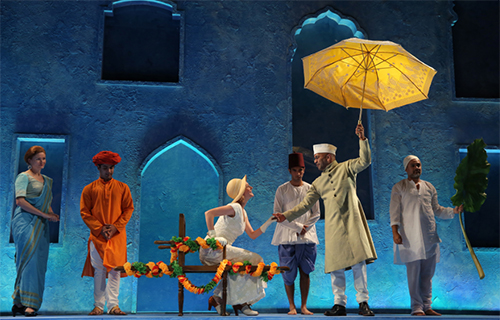Tom Stoppard's characters are seldom at a loss for words, and the chatty creatures of Indian Ink are no exception, debating subjects of art, language, and empire. So it's striking that one of the first significant arguments in the play---originally written in the mid-1990s, and now making a belated New York debut at the Roundabout's Laura Pels Theatre---erupts over something unsaid.
A free-spirited English poet, Flora Crewe, on holiday in India in the 1930s, has agreed to sit for a portrait by an Indian painter, Nirad Das. At first they amicably compare notes on their respective artistic processes and cultural traditions, but Flora grows increasingly frustrated with Nirad's courtly, English-educated manners. She wishes he would act "more Indian," though she has little idea what that means. Nirad, meanwhile, is gravely wounded when he realizes that Flora has sneaked a peek at his painting in progress and said nothing to him about it.
"What happens all the time between the two of them is this insane culture of misunderstanding," says director Carey Perloff. "She'll say something and he gets offended; he says something and she gets offended; and they don't mean it at all."
Perloff, who also staged Indian Ink's 1998 American premiere at San Francisco's American Conservatory Theater, where she's artistic director, has a thoughtful take on this tangle of miscommunications: "Flora first doesn't look at the painting because she doesn't want to be put in the position of judgment, because she knows as an artist how painful judgment is. And when she does look, she's disappointed. She thought it would be what she thinks Indian painting is, and it isn't that, so she doesn't say anything.
"Then, when Nirad realizes that she's looked and hasn't said anything---we artists are the most thin-skinned people on the planet; we remember every bad review verbatim---he's mortified that she wouldn't have said anything. And then she's mortified that he's not an artist enough to have his own barometer, that he would care what she thinks."
This being Stoppard, the play's interpretive layers don't stop there. The uneasy period romance unfolds from the present-day memories of Flora's sister, who's in conversation with both an American poetry scholar and Nirad's own son. The contemporary characters all have their reasons for wondering about Flora and Nirad's relationship, and what emerges from all this biographical puzzling is a recurrent Stoppardian theme---what Perloff calls "the eroticism of ideas."
But what is that, really?
Perloff explains, "What I've always loved so much, both about Tom Stoppard as a person and about his writing, is that he completely understands that there's something really sexy about a great idea and that the bandying about of thoughts is a kind of charged experience which can have sexual heat. It's true in all of his plays that people fall in love through ideas or, in this play, through art. Art is the aphrodisiac in this play."
---
Rob Weinert-Kendt is a senior editor at American Theatre and writes regularly about theatre for the New York Times
Photo by Joan Marcus
